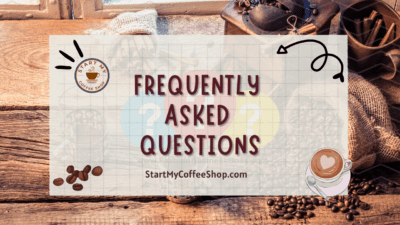Are you thinking about opening a coffee shop? It can be an exciting venture, but it can also be a challenging one. There are many things to consider before you open your doors to the public. From finding the perfect location to hiring the right staff, there are a lot of moving parts to this process. In this article, I will cover everything you need to know about opening a coffee shop.
To open your coffee shop you need to know the essential steps such as writing a business plan, finding the perfect location, funding & designing your coffee shop, hiring employees, menu planning, marketing, managing finances, managing inventory, handling legal issues, and providing excellent customer service. The article offers valuable insights and advice to help readers start a coffee shop that stands out in their community.
Writing a Business Plan
The first step in opening a coffee shop is writing a business plan. This plan will serve as a roadmap for your business and will help you identify the resources you need to succeed. Your business plan should include:
- A description of your coffee shop
- A market analysis
- Your target demographic
- Your marketing plan
- Your budget
- Your sales and revenue projections
A well-written business plan will help you secure funding and stay on track as you launch your coffee shop.
Finding the Perfect Location
Once you have a business plan, the next step is to find the perfect location for your coffee shop. Consider these factors such as foot traffic, parking, and visibility when selecting a location. You’ll also want to think about the demographic of the area and whether it aligns with your target audience. Keep in mind that the location you choose can make or break your coffee shop, so take the time to choose wisely.
1. Demographics
Consider the demographics of the area where you plan to open your coffee shop. Look for neighborhoods with a high concentration of your target demographic, such as college students, young professionals, or families. Also, consider the age, income, and lifestyle of the residents in the area.
2. Foot Traffic
Foot traffic refers to the number of people who pass by your coffee shop. Look for locations with high foot traffic, such as busy commercial areas, shopping malls, or transportation hubs. High foot traffic means more potential customers and more opportunities for your business to be seen.
3. Accessibility

Ensure that your coffee shop is easily accessible to customers. Look for locations with plenty of parking or easy access to public transportation. The location should be visible and easy to find.
4. Competitors
Consider the competition in the area where you plan to open your coffee shop. Look for locations where there are few or no direct competitors. If there are competitors, consider how you can differentiate your business and stand out from the competition.
5. Evaluating Potential Locations
Once you’ve identified potential locations, you’ll need to evaluate each one based on the factors discussed above. Here are some tips for evaluating potential locations:
- Visit the location at different times of the day to gauge foot traffic and customer flow.
- Research the local competition and their offerings to determine how you can differentiate your business.
- Consider the cost of renovations and upgrades to the location to fit your coffee shop’s needs.
- Consult with a commercial real estate agent to help you evaluate the location and negotiate the lease.
Read more about How to Create a Successful Coffee Shop Investment Plan: The Coffee Shop Business Plan Blueprint
Funding Your Coffee Shop
Opening a coffee shop requires a significant amount of funding. You’ll need to invest in equipment, supplies, inventory, and staffing. Depending on the size and location of your coffee shop, you may also need to renovate the space to make it suitable for your business. There are several ways to fund your coffee shop, including:
- Personal savings
- Small business loans
- Crowdfunding
- Investors
Consider your options carefully and choose the funding source that works best for your situation.
Designing Your Coffee Shop
The design of your coffee shop is important for creating a welcoming and comfortable environment for your customers. You’ll also want to think about the accessibility of your coffee shop and how it will impact the flow of customers. Here are the factors that will help you in designing your coffee shop:
1. Layout and Seating
The layout and seating of your coffee shop can significantly impact the overall ambiance and customer experience. Consider the flow of traffic and the positioning of your counters, seating areas, and restrooms. You’ll also want to choose seating options that are comfortable and functional, such as chairs, benches, and bar stools.
2. Lighting and Color Scheme
Lighting and color scheme are crucial elements of the overall ambiance of your coffee shop. Bright, natural lighting can create a warm and inviting atmosphere, while dim lighting can create a cozy and intimate setting. Your color scheme should complement your branding and create a cohesive look and feel for your shop.
3. Décor and Branding
Your coffee shop’s décor and branding should reflect your unique style and vision. Consider incorporating elements such as artwork, plants, and signage to create a welcoming and visually appealing environment. Your branding should be consistent throughout your shop, including your logo, packaging, and marketing materials.
4. Equipment and Supplies
The equipment and supplies you choose for your coffee shop can significantly impact the quality of your products and the efficiency of your operations. Invest in high-quality coffee machines, grinders, and brewing equipment, as well as supplies such as cups, lids, and utensils.
5. Accessibility and Comfort
Accessibility and comfort are essential considerations when designing your coffee shop. Ensure that your shop is accessible to all customers, including those with disabilities. Additionally, provide amenities such as Wi-Fi, charging stations, and comfortable seating to create a comfortable and convenient environment for your customers.
Hiring Employees
Your employees are an essential part of your coffee shop’s success. You’ll need to hire a team that is friendly, knowledgeable, and passionate about coffee. Consider the skills and experience you’re looking for when hiring employees. You’ll also want to create a training program to ensure your employees are equipped with the skills they need to provide excellent customer service.
When hiring employees, consider the following factors:
1. Experience and Skills
Experience and skills are important factors to consider when hiring employees for your coffee shop. Look for individuals who have experience in the coffee industry or a similar field, such as food service. They should also have the necessary skills to prepare and serve high-quality coffee, such as knowledge of brewing methods, latte art, and customer service.
2. Attitude and Personality
The attitude and personality of your employees can greatly impact the success of your coffee shop. Look for individuals who are friendly, outgoing, and have a positive attitude. They should be passionate about coffee and customer service and be willing to go above and beyond to ensure customer satisfaction.
3. Availability and Flexibility
When hiring employees, consider their availability and flexibility. Coffee shops typically have early morning and late evening hours, so you’ll want to hire individuals who are willing to work during those times. Look for individuals who are flexible and able to work weekends and holidays if needed.
4. Training and Development
Training and development are essential for ensuring your employees have the skills they need to provide excellent customer service and prepare high-quality coffee. Provide comprehensive training to your employees on coffee preparation, customer service, and other essential skills. Consider offering ongoing development opportunities, such as coffee tasting classes or training on new brewing methods.
Menu Planning
Your coffee shop’s menu is another important consideration. You’ll want to offer a variety of coffee drinks, as well as other food and beverage options. Consider the preferences of your target demographic when planning your menu. You’ll also want to consider the following factors for a better menu for your coffee shop:
1. Determine Your Specialty
One of the first things you should do when menu planning for your coffee shop is to determine your specialty. Will you specialize in a particular type of coffee, such as espresso or pour-over? Will you offer unique flavor profiles or blends? Whatever your specialty is, make sure it’s highlighted on your menu and that your customers are aware of it.

2. Offer a Variety of Beverages
While coffee may be the star of the show, you’ll also want to offer a variety of other beverages on your menu. Consider offering tea, hot chocolate, smoothies, and iced drinks to appeal to a broader customer base. You may also want to offer non-dairy milk alternatives for customers with dietary restrictions.
3. Consider Food Options
In addition to beverages, you may also want to consider offering food options on your menu. Consider items such as pastries, sandwiches, salads, and snacks to complement your coffee offerings. Make sure to use high-quality ingredients and consider offering vegetarian and gluten-free options.
4. Price Your Items Appropriately
Pricing is another critical aspect of menu planning. You’ll want to price your items appropriately to cover your costs while still remaining competitive with other coffee shops in your area. Consider using a pricing strategy such as keystone pricing, where you double the cost of the item to determine the retail price.
5. Present Your Menu Creatively
Finally, how you present your menu can impact your customers’ experience. Consider using creative and visually appealing menu boards, table tents, or digital displays to showcase your menu items. You may also want to provide descriptions of your specialty items or suggest food and drink pairings.
Read more about Attracting Investors for Your Coffee House Business: A Step-by-Step Business Plan Guide
Marketing Your Coffee Shop
Marketing is an essential aspect of any business, and your coffee shop is no exception. You’ll want to create a marketing plan that includes both online and offline strategies. Some examples of marketing strategies you may want to consider include:
1. Online Strategies
- Social media marketing: Use platforms like Facebook, Instagram, and Twitter to promote your coffee shop and engage with your customers.
- Email marketing: Build an email list and send out regular newsletters and promotions.
- Local advertising: Place ads in local newspapers, magazines, or radio stations.
- Community events: Host or participate in community events to promote your coffee shop and build relationships with your customers.
2. Offline Strategies
- Local advertising: Place ads in local newspapers, magazines, or radio stations to reach potential customers in your area
- Community events: Host or participate in community events to promote your coffee shop and build relationships with your customers. Consider sponsoring events or offering catering services for community events
- Word of mouth: Encourage your satisfied customers to spread the word about your coffee shop. Offer loyalty programs or referral bonuses to incentivize customers to bring in their friends and family.
Managing Your Finances
Managing your finances is essential for the success of your coffee shop. You’ll need to keep track of your expenses and revenue, as well as pay taxes and manage payroll. Consider these factors to help you stay on top of your finances:
1. Create a Budget
The first step in managing your finances is to create a budget. A budget is a plan that outlines your expected income and expenses for a given period. Start by estimating your monthly income and expenses, including rent, utilities, payroll, inventory, and marketing. Be sure to include all costs, even the small ones, as they can add up over time.
2. Keep Track of Your Expenses
Once you have a budget in place, it’s essential to keep track of your expenses. Keep all of your receipts and invoices organized, and record them in a spreadsheet or accounting software. By doing so, you can track your spending and ensure that you stay within your budget.
3. Monitor Your Cash Flow
Cash flow is the amount of money that comes in and goes out of your business. Monitoring your cash flow is crucial to ensuring that you have enough money to cover your expenses. Keep track of your cash flow by recording your daily sales and expenses, and compare them to your budget. If you notice any discrepancies, take action to address them.
4. Hire an Accountant
Hiring an accountant can be an excellent investment for your coffee shop. An accountant can help you with tasks such as bookkeeping, payroll, and tax preparation. They can also provide valuable advice on financial planning and help you make informed decisions about the future of your business.
5. Use Accounting Software
If you don’t have the budget to hire an accountant, consider using accounting software. There are many affordable options available that can help you with tasks such as invoicing, expense tracking, and financial reporting. By using accounting software, you can save time and ensure that your finances are organized and accurate.
Managing Inventory
Managing inventory is crucial to the success of a coffee shop. To effectively manage inventory, it is important to track inventory, set par levels, use inventory management software, and conduct regular audits. By implementing these strategies, coffee shop owners can ensure that they always have enough supplies on hand to run their business efficiently while minimizing waste and maximizing profits.
1. Use Inventory Management Software
Consider investing in inventory management software to help you stay organized and track your inventory levels. These software programs can provide you with real-time data on your inventory levels, sales, and orders. This can help you make informed decisions about when to order new supplies and how much to order.
2. Track Your Inventory Levels

Regularly track your inventory levels to ensure that you always have enough supplies on hand. You can do this manually by counting your inventory regularly, or by using barcode scanners or other automated tracking tools.
3. Set Par Levels
Set par levels for each item in your inventory. Par levels are the minimum quantity of a product that you need to have on hand at all times. This can help you avoid running out of supplies and ensure that you always have enough to meet demand.
4. Monitor Your Sales
Monitor your sales data to identify trends and adjust your inventory levels accordingly. If you notice that a particular product is selling quickly, you may need to order more to ensure you have enough to meet demand.
5. Rotate Your Inventory
Rotate your inventory to ensure that you’re using the oldest products first. This can help you avoid wasting inventory by letting products expire or go stale. Use the FIFO (first in, first out) method to ensure that you’re using your inventory in the correct order.
6. Conduct Regular Audits
Conduct regular audits of your inventory to identify any discrepancies and ensure that your records are accurate. This can help you avoid overstocking or understocking items.
Read more about Building a Solid Plan for Your Small Coffee and Juice Shop
Handling Legal and Regulatory Issues
Opening a coffee shop also involves dealing with legal and regulatory issues. You’ll need to obtain the necessary permits and licenses to operate your business legally. Consider consulting with a lawyer to ensure you’re in compliance with local laws and regulations
Providing Excellent Customer Service
Providing excellent customer service is crucial for the success of your coffee shop. Your customers should feel welcome and appreciated when they visit your shop. Train your employees to provide exceptional customer service, and always prioritize the needs and satisfaction of your customers.
1. Train Your Employees
The first step in providing excellent customer service is ensuring your employees are trained to do so. Train your employees on how to greet customers, take orders, and handle complaints or issues. Make sure they understand the importance of making customers feel welcome and valued.
2. Create a Welcoming Environment
The environment of your coffee shop can make a big difference in how customers feel. Make sure your shop is clean and well-maintained, with comfortable seating and a welcoming atmosphere. Play music that fits the vibe of your shop, and consider adding some plants or artwork to make it feel cozy and inviting.
3. Offer High-Quality Products
While providing great customer service is crucial, you also need to offer high-quality products to keep customers coming back. Make sure your coffee beans are fresh and roasted to perfection, and consider offering a variety of drinks and snacks to appeal to a broad range of customers.
4. Be Attentive to Customer Needs
One of the most important aspects of providing excellent customer service is being attentive to your customers’ needs. Listen to their requests and concerns, and make an effort to personalize their experience. Remember regular customers’ orders and preferences, and be proactive in offering suggestions or recommendations based on their preferences.
5. Respond to Feedback
Feedback from customers can be incredibly valuable in improving your coffee shop and providing better customer service. Encourage customers to provide feedback, either in person or through online reviews or surveys. Respond promptly and professionally to any negative feedback, and take steps to address any issues or concerns
Summary
Opening a coffee shop can be a rewarding and profitable venture. However, it requires careful planning and execution to ensure success. By following the steps outlined in this article, you can increase your chances of opening a successful coffee shop. Remember to focus on providing excellent customer service, creating a welcoming environment, and implementing effective marketing strategies. With the right approach and dedication, your coffee shop can become a beloved part of your community.
Frequently Asked Questions:

1. How much does it cost to open a coffee shop?
– The cost of opening a coffee shop can vary depending on factors such as location, size, and equipment. On average, you can expect to spend between $80,000 and $250,000.
2. Do I need experience to open a coffee shop?
– While having experience in the coffee industry can be helpful, it’s not necessary to open a coffee shop. You can learn about the industry and gain the necessary skills through research and training.
3. How long does it take to open a coffee shop?
– The timeline for opening a coffee shop can vary depending on factors such as location and funding. On average, it can take between six months to a year to open a coffee shop.
To learn more on how to start your own coffee shop checkout my startup documents here
Please note: This blog post is for educational purposes only and does not constitute legal advice. Please consult a legal expert to address your specific needs.

Hi! I’m Shawn Chun
My adventure in coffee began when I first launched my first coffee shop back in the early 2000s. I had to figure out so many things on my own and to make it worse within 2 years of opening two large corporate coffee chains moved in just blocks away from me!
As I saw smaller and even some larger coffee shops in the neighborhood slowly lose customers to these giant coffee chains and slowly close up shop, I knew that I had to start getting creative…or go out of business.
I (like you may be) knew the coffee industry well. I could make the best latte art around and the foam on my caps was the fluffiest you have ever seen. I even had the best state-of-the-art 2 group digital Nuova Simonelli machine money could buy. But I knew that these things alone would not be enough to lure customers away from the name brand established coffee shops.
Eventually, through lots of trial and error as well as perseverance and creativity I did find a way to not only survive but also thrive in the coffee/espresso industry even while those corporate coffee chains stayed put. During those years I learned to adapt and always faced new challenges. It was not always easy, however, in the end, I was the sole survivor independent coffee shop within a 10-mile radius of my location. Just two corporate coffee chains and I were left after that year. All told the corporate coffee chains took down over 15 small independent coffee shops and kiosks and I was the last one standing and thriving.
Along the years I meet others with the same passion for coffee and I quickly learned that it is not only “how good a barista is” that makes a coffee shop successful, but the business side of coffee as well.
Hence why I started this website you are on now. To provide the tools and resources for up and coming coffee shop owners to gain that vital insight and knowledge on how to start a coffee shop successfully.
Stick around, browse through my helpful blog and resources and enjoy your stay! With lots of LATTE LOVE!
Shawn







